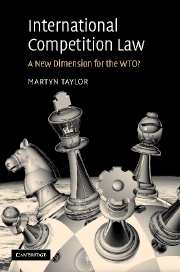Book contents
- Frontmatter
- Contents
- List of tables and figures
- List of abbreviations
- 1 Introduction
- PART I An International Competition Agreement is Desirable
- PART II The WTO Would Provide a Suitable Institutional Vehicle
- 6 Would the WTO provide a suitable institutional vehicle for an international competition agreement?
- 7 Would a WTO competition agreement promote international trade?
- 8 Would competition regulation of trade measures promote competition?
- 9 Should competition principles be introduced into anti-dumping law?
- PART III The Optimal Form for a WTO Competition Agreement
- APPENDIX: Draft negotiating text for a plurilateral WTO competition agreement
- Index
8 - Would competition regulation of trade measures promote competition?
Published online by Cambridge University Press: 17 July 2009
- Frontmatter
- Contents
- List of tables and figures
- List of abbreviations
- 1 Introduction
- PART I An International Competition Agreement is Desirable
- PART II The WTO Would Provide a Suitable Institutional Vehicle
- 6 Would the WTO provide a suitable institutional vehicle for an international competition agreement?
- 7 Would a WTO competition agreement promote international trade?
- 8 Would competition regulation of trade measures promote competition?
- 9 Should competition principles be introduced into anti-dumping law?
- PART III The Optimal Form for a WTO Competition Agreement
- APPENDIX: Draft negotiating text for a plurilateral WTO competition agreement
- Index
Summary
Chapter 8 continues the examination commenced by Chapter 7 into the relationship between international competition law and international trade law. Chapter 8 now considers international trade measures from a competition perspective, adopting the converse but complementary view to Chapter 7.
The distinction between the analysis set out in Chapters 7 and 8 of this book is a subtle but crucial one:
Chapter 7 adopted an international trade perspective on anti-competitive conduct. Chapter 7 considered the extent to which private anti-competitive conduct is not effectively regulated by either international trade law or domestic competition law, with resulting adverse affects on international trade. Given that private anti-competitive conduct is not usually directly regulated by international trade law (as evidenced by the Kodak-Fuji case), Chapter 7 focused primarily on under-regulation in the application, enforcement and substantive content of domestic competition laws. Chapter 7 concluded that such under-regulation could be addressed by an international competition agreement.
Chapter 8 now adopts an international competition perspective on international trade measures. Chapter 8 therefore considers the extent to which governmental trade measures are not effectively regulated by either international trade law or domestic competition law, with resulting adverse affects on international competition. Given that governmental trade measures are not usually directly regulated by domestic competition laws, Chapter 8 focuses primarily on under-regulation in the application, enforcement and substantive content of international trade law. Chapter 8 similarly considers how such under-regulation could be addressed by an international competition agreement.
- Type
- Chapter
- Information
- International Competition LawA New Dimension for the WTO?, pp. 224 - 259Publisher: Cambridge University PressPrint publication year: 2006



